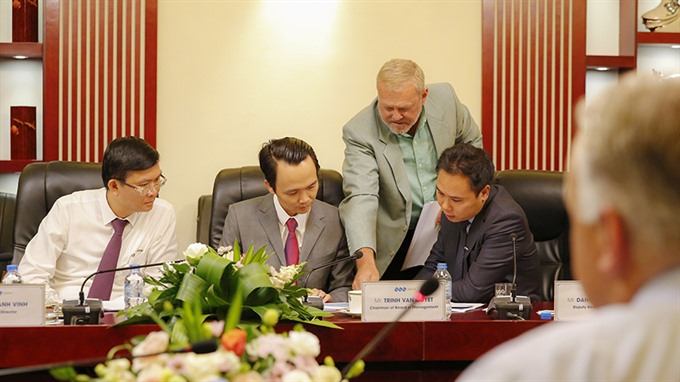 Economy
Economy

Việt Nam needs more airlines, besides the four current ones, to meet the increasing demand in the aviation market.
 |
| Bamboo Airways signed a memorandum of understanding to buy the latest version of Airbus A321 Neo from Airbus Group for the airline’s operations. — Photo FLC |
HÀ NỘI — Việt Nam needs more airlines, besides the four current ones, to meet the increasing demand in the aviation market.
The Ministry of Transport (MoT) has completed a draft plan to expand the aviation sector for the 2018-20 period with a vision to 2030 and is currently collecting feedback from related agencies before submitting the draft to the Prime Minister.
According to MoT, the aviation market’s annual growth rate will be 16 per cent from now to 2020 and 8 per cent from 2020 to 2030. Local airlines are expected to serve 64 million passengers by 2020 and 131 million passengers by 2030. MoT aims to expand the airlines’ fleet to 220 planes by 2020 and 400 planes by 2030.
Việt Nam currently has seven aviation companies, out of which only four are commercial airlines, with 180 planes. The rate of customers travelling by air increased from 0.5 per cent in 2012 to 0.8 per cent in the first half of 2016. This shows that more people are using airlines.
In recent years, Vietnamese people’s tendency to travel abroad by air has increased, especially of visitors.
According to statistics of the Việt Nam National Administration of Tourism, there were 6.5 million Vietnamese travelling abroad in 2016. This figure is expected to surge by 9.5 per cent within the next five years.
Leaders of local airlines assess that the country needs some 10 airlines to meet the demand and make it a healthy competitive market.
However, aviation investments face obstacles in both planning and administrative procedures. It takes between three to four years to establish a new aviation company.
The aviation plan must be compatible with the State’s master plan and must be reviewed by MoT as well as the Ministry of Planning and Investment at the same time. That is why many companies, such as Vietstar Airlines, still have not started commercial flights.
The local authorities postponed issuing permits to Vietstar Airlines because of overloading at Tân Sơn Nhất Airport. Tân Cảng and Việt Bamboo Airlines still need to submit their documents to the Ministry of Planning and Investment.
According to experts, the aviation sector’s planning adjustment this year will help boost the investment process.
New opportunities
At a meeting in November 2017, Deputy PM Trịnh Đình Dũng noted that the aviation sector’s planning adjustment was necessary to create a legal framework to continue developing the market in the future.
Catching up with the trend, some private firms have announced their plans to invest in airports and airlines. They include Vietstar Airlines, Tân Cảng and Bamboo Airways of Việt Bamboo Airlines Company, a subsidiary of FLC Group.
FLC said priority would be given to localities where it has built major tourist complexes, including Quảng Ninh Province and Hải Phòng City in the north, Thanh Hóa and Bình Định provinces in the central region, and Nha Trang City (Khánh Hòa Province) and Phú Quốc Island (Kiên Giang Province) in the south.
Bamboo Airways will be a “hybrid” airline, which will blend low-cost traits with those of traditional or full-service carriers.
FLC has also invested in infrastructure for aviation operations, such as upgrading Phù Cát Airport in Quy Nhơn City and key roads connecting the airport to Nhơn Hội Economic Zone.
Currently, the Bamboo Airways is completing infrastructure to bring its first flight into operation in 2019.
Đặng Tất Thắng, general director of Việt Bamboo Airlines Company, said the company had signed a memorandum of understanding to buy the latest version of Airbus A321 Neo from Airbus Group for the airline’s operations. — VNS